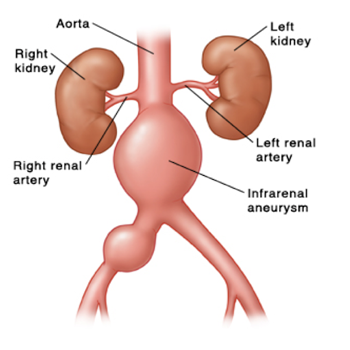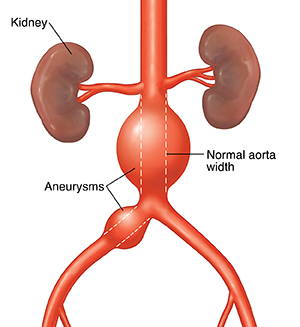What is the aorta?
The aorta is the largest artery (blood vessel) in the body. It carries blood from the heart, through the chest and the abdomen. Many smaller arteries come off the aorta to supply blood to all parts of the body. When the aorta reaches the pelvis it divides into two iliac arteries, one going to each leg.
What is an aneurysm and an abdominal aortic aneurysm?
An aneurysm occurs when the wall of a blood vessel is weakened and balloons out. In the aorta, this ballooning makes the wall weaker and more likely to burst. Aneurysms can occur in any artery, but they most commonly occur in the section of the aorta that passes through the abdomen. These are known as abdominal aortic aneurysms (AAA).

What causes an AAA?
The exact reason why an aneurysm forms in the aorta is not often clear. Aneurysms can affect both men and women of any st common in men, people with high blood pressure (hypertension) and those over the age of 65.
The wall of the aorta normally has layers of supporting tissues. As people age, they may lose some of this tissue. This is thought to be the reason why aneurysms are more common in older people.
Your genetic make–up can also be a reason; you have a much higher chance of developing an AAA if one of your immediate relatives (parent, brother or sister) has or has had one before.
Certain other ‘risk factors‘ increase the chance of getting an aneurysm. These include:
- smoking
- high blood pressure
- high cholesterol
- lung damage, such as emphysema (chronic obstructive pulmonary disease)
- obesity (being overweight)

How are aneurysms discovered?
The majority of AAAs cause no symptoms and are discovered by chance. A routine examination by a doctor, or an X–ray or scan performed for some other reason may pick up the presence of an aneurysm. Some people notice an abnormal pulsation in their abdomen. As the aneurysm stretches it can also cause pain in your back or abdomen. Regular screening for AAAs has been introduced for all men over the age of 65 across the country. This is performed using an ultrasound scan. An ultrasound uses sound waves to create images of your internal organs on a screen. The scan will tell us if there is an aneurysm present and exactly how large it is.
Sometimes we will need to carry out a more detailed CT scan (computerised tomography scan). This may be done if your doctor needs to know whether the aneurysm is affecting any of the arteries that come off of the aorta.
If your doctor thinks you may have an aortic aneurysm after examining you, or has confirmed an aneurysm on an ultrasound, they will refer you to a Vascular Surgeon for advice.
What are the symptoms of an AAA?
Aneurysms generally take years to develop and it is rare for them to give symptoms during this time.
If you do develop symptoms, you may experience one or more of the following
- a pulsing feeling in your abdomen, similar to a heartbeat
- pain in your abdomen or lower back
Do I need an operation to treat my aneurysm?
Not if your aneurysm is small. Research has shown that for people with aneurysms measuring less than 5.5cm (about 2 inches), it is safer not to operate, as the risks of having an operation are greater than the benefit.
Most small aneurysms will not need treatment when they are discovered, but will need to be watched with regular ultrasound scans. If the aneurysm gets larger then you may need to have the aneurysm repaired.
When we carry out the ultrasound screening we will measure the size of your aneurysm. This is a quick and painless test and is similar to the scans done on pregnant women to show a picture of their baby. We use a handheld ultrasound ‘pen‘ over the skin on your abdomen, to show up the aneurysm. How often you will need to have a scan will depend on the size of your aneurysm. If your AAA is small it is likely that you will only need a scan once a year. The results of the scan will be explained to you and you will be told the size of your aneurysm. If this is your first appointment we may need you to come to a further appointment at the hospital clinic to be examined.
If you have any worries or concerns about your aneurysm you can discuss them with your Vascular Surgeon or Specialist Nurse. If your aneurysm starts to produce symptoms, or rapidly increases in size (as measured by the scan), you will be seen by your Vascular Surgeon. You may then need an operation to repair the artery There are two main operations to repair an aneurysm; an open aneurysm repair and an endovascular aneurysm repair (EVAR). If your surgeon recommends an operation we will give you more information to explain what will happen.
Why do I need to have my aneurysm checked regularly?
The larger your aneurysm becomes, the more chance there is of it causing serious problems. Most abdominal aortic aneurysms occur at the lower end of the aorta. In this position they can get bigger without causing any symptoms. Most aneurysms grow
slowly at a rate of about 3mm (1/8th inch) per year. However, larger aneurysms are more likely to grow quickly, so scans will be carried out more frequently as the AAA enlarges. If an AAA gets too large there is an increased risk that it may leak or rupture (burst) without any warning.
What is the chance of a small AAA rupturing?
The chance of rupture is very low for small AAAs. For aneurysms measuring less than 5.5cm in diameter the risk of rupture is less than 1 in 100 per year. As aneurysms get larger than 5.5cm, the risk of rupture increases and it is usually at this size that the option of surgery is considered.
At any size, rupture risk is increased in smokers, those with high blood pressure, and those with a family history of an AAA. Every person‘s risk from their AAA and from surgery may be different. Any decision on treatment will be carefully considered by your Vascular Team and always discussed in detail with you and, when appropriate, your family.
Do I need to take things easy?
There is no need to limit your everyday activity now that you have been told you have an aneurysm. Moving around, lifting and exercise will not affect your aneurysm or cause damage. Exercise is important to improve your health and make you fitter and stronger for an operation, if you need one.
Driving with an AAA
If you have a small AAA (smaller than 5.5cm) you are allowed to continue to drive.
The DVLA should be notified if your aneurysm reaches 6cm in diameter, but you are allowed to continue to drive if you have had satisfactory medical treatment and there is no further enlargement of your AAA. If your AAA reaches 6.5cm in diameter the DVLA will have to withdraw your licence. You can reapply for your licence if your AAA is successfully treated.
If you drive an HGV or Public Service Vehicle (PSV), the DVLA will withdraw your licence if your AAA reaches 5.5cm in diameter.
What can I do to help myself?
What do I do if I get new symptoms?
If you experience sudden onset of new severe abdominal pain or back pain that is different from any back pain you may have had previously, this means you may be developing a leak from your AAA or are at immediate risk of rupture
If you experience any of these symptoms please dial 999 for an ambulance. Tell the operator that you have an aortic aneurysm and need to go to hospital urgently. Do not drive yourself to hospital.
